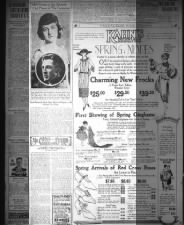.jpg)
Ye Olden Oakland Days
(Contributed by Oakland Pioneers - No. 73)
OLD BUILDINGS - SOME CORRECTIONS
Two stories have recently gone the rounds of the press about the bay, both of which are much at variance with Oakland's early history. The first is that Louis Monnet came to California in 1850 and located in Eureka, that in 1870 he made his home in Oakland where he established the first butcher shop ever opened here, his shop being on the corner where the First National Bank building now stands; that a man who kept a restaurant ran up a bill with him for $200 and, as he was about to leave Oakland, offered Monnet the corner bounded by Fourteenth and Fifteenth streets, Broadway and San Pablo avenue in payment of the bill, which Monnet refused and thereby missed the great opportunity of becoming a very wealthy man. While this makes a very good story, there is no accuracy in it.
At the alleged date of Mr. Monnet's locating in Oakland, there were about 20,000 people residing here and butcher shops were quite numerous. Sabe Harris opened one on the West side of Broadway just north of First street, in the fifties and from that time on they increased in number. There never was a butcher shop on the corner in question, though I think there was one on the Broadway side of the building.
The first building erected on the corner was a narrow two-story dwelling-house, occupied by a Mrs. Shorkley, in the early fifties. Geo. Lee, a florist, purchased the entire gore from Fourteenth street to the Charter Line in 1856 from J. K. Irving, et als., and as Mrs. Shorkley held no title to the corner, she was dispossessed.
Lee raised flowers on this tract and sold them in San Francisco and the place was known for several years as Lee's Garden. About 1860, George C. Potter purchased the property and in 1876 built a two-story wooden building on the corner and one-story in the rear, a part of which now stands at the north of the bank building. The upper story on the corner was occupied by Dr. Lane, dentist, father of Hon. Franklin K. Lane. About 1884 Eli W. Playter bought the property and made the rear part of the building two stories. His heirs are now the owners or the land.
The property alleged to have been offered to Mr. Monnet would have been easily worth, in 1870, several thousand dollars. The first business block on the corner was erected in 1876. It is therefore seen that the story does not fit this corner.
The other story is that Joseph Herzog built the first brick building in Oakland; laid out the first tract of land that was subdivided and sold in lots and the first wide street in Berkeley, which he named Herzog ave., and which was afterward changed to Alcatraz avenue.
I knew Mr. Herzog well and I honor him for his perseverance and his being willing to start in a small way and work his way up to a fortune, which he did. He came to Oakland in the latter part of 1856 and after a year or two, he bought an old white horse, on which he placed two packs and led the horse about by the halter. By 1862 he was able to and did purchase from Judge S. B. McKee a 25-foot lot on the west side of Broadway, seventy-five feet north from Third Street, for which he paid $1800. He made an agreement with the "Oakland Guard" that he would build a two-story brick building, if they would rent the upper story for an armory at $20 per month, which agreement was carried out. The hall was also rented to the Good Templars.
This building is still standing but it is not the first brick building erected in Oakland, as the following named brick.structures, all now standing, were built previous to the Herzog building.
On the northwest corner of Broadway and Third street and just south of the Herzog building stands the first brick structure in Oakland. It is one-story and was at first occupied by Madame St. Germain as a grocery store; on the corner to the north in the same block the one-story brick building known as the "Mariposa" and occupied by John Gagnon and also by John McCann; across Broadway and a little to the north, the two-story brick builds of S. Hirshberg, used as a clothing store, the upper story being a Masonic Hall; at the southwest corner of Broadway and Second street, a two-story brick building occupied by Wm. Hurll and the two-story brick building known as the "Hotel de France" on the south side of First street, east of Broadway.
The Herzog tract of about ten blocks, lying partly in Oakland and partly in Berkeley, was subdivided in 1887, long after numerous other tracts had been subdivided and placed on sale. Alcatraz avenue, running east and west, was already laid out and so named when the map of the Herzog tract was filed, while Herzog street, laid out by Mr. Herzog, ran north and south and it was not this street which became Alcatraz avenue.




